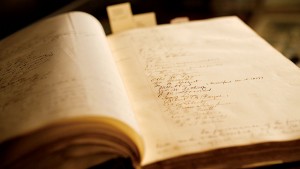In the age of electronic documents and cloud storage, one thing remains tangible at Kenyon: the Matriculation Book.
Three leather-bound books, tucked into protective boxes, are housed in the vault in the Greenslade Special Collections and Archives in Chalmers Library. Each year, they’re brought out for all first-year students to sign on Founders’ Day.
The first book, with its thick pages yellowing at the edges, contains the fading handwritten script of then-president David Bates Douglass’ speech launching the rite of matriculation, or the official admission into Kenyon. Following that speech on July 17, 1841, which called the conditions of matriculation “wholly of a moral character,” students signed the book, pledging their allegiance to their alma mater.
Today, almost 24,000 students have signed the book. The first volume contains signatures from 1841 through 1956, and the second volume covers 1957 through 2010. A third volume, now less than a quarter full, was started in 2011.
“They’re beautiful,” said Tom Stamp ’73, College historian and keeper of Kenyoniana. “They’re like Kenyon family bibles.”
Signing the book never has been a condition of graduation, Stamp said. Many students do not sign while enrolled for various reasons but come back later to do so. One of the most famous late signers was best-selling author John Green ’00, who missed adding his signature because he was busy writing on Founders’ Day in 1996. He signed the book in 2014 when he was on campus to give a talk. His signature is one of the most requested to view along with those of Rutherford B. Hayes, Class of 1842, Paul Newman ’49 H’61 and E.L. Doctorow ’52 H’76.
The book rarely leaves the archives, but it is brought out on several occasions in addition to Founders’ Day — for Family Weekend, Reunion Weekend and Commencement. The book also can be viewed by appointment. “We have guests a few times a week,” said Abigail Tayse, the College archivist.
Today, students use special pens with acid-free ink that won’t degrade the paper, so signatures won’t fade as the text of Bates Douglass’ speech has. And even though they are allowed to practice signing their names before recording them among all the others, a few students every year still make mistakes, Tayse says. The most common? “They misspell their names.”
